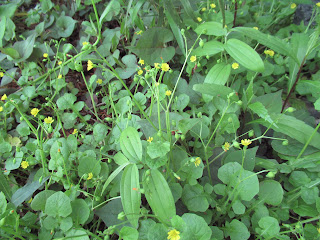 |
| In Yokohama, a meadow bunting is singing, “Spring!” |
The State of Emergency against Covid-19 lets me have a weekly walk in my neighborhood. It was a sort of lucky the time began early April, coinciding with spring. Since then, the scenery in our forests changes continuously. At the start, it was for spring ephemerals like violets. Only a week later golden ray florets showed off their happy faces, while bluish flowers of Veronica family started modestly. In early May, many yellow flowers have become a mixture of fluffs and flowers, but Veronicas are now larger and/or taller. Yellow and white flowers of Rosaceae also appeared early April, and in May many of them have maturing fruits. It is difficult to decide a “right” moment to collect their wild strawberries before birds do …One weekend, some pokes their cute flowers, and next week another genius calling our attention at the same place. Where is the protagonist of last week now? I’m walking with my new portable reference book these days. My book is in the latest APG system! There are so many things to learn … Then, I noticed.
 |
| Oriental false hawksbeard (Youngia japónica) |
 |
| Lapsana
humilis, which is a relative to Oriental false hawksbeard. |
 |
| Ranunculus cantoniensis |
 |
| Old friend Oxalis corniculata |
 |
| Duchesnea
Chrysanta. Its fruit is edible, but does not taste at all. So no one cares. |
 |
| Pervasive Veronica
persica. We know it was first identified as transplants from Europe in 1887. |
 |
| Gentiana zollingeri |
 |
| Hello, cucumber herb (Trigonotis peduncularis) ! |
 |
| Hemisteptia
iyrata. My senior for Niiharu Lovers told me it appeared here this year for the first time as long as he remembers … But why, then? |
When I was a small kid, dandelions, chickweeds, Chinese plantains, jersey cudweeds … were the regulars in our playground here in Yokohama. They were modest flowers, except violets. When I could occasionally meet with cucumber herbs, I was very happy with their tiny baby blue flowers. Now, in our neighborhood, there are more big, “self-asserting” flowers, it seems to me. They are not in established gardens, but wildflowers on roadside. Yes, there could have been alehoofs (Glechoma hederacea) and Ajuga decumbens before. I guess I did not notice them. But I’m not sure if there were this much yellow of prickly sowthistle (Sonchus asper), or red deadnettle (Lamiun purpureum). Yeah, Carolina cransbills (Geranium carolinianum) are pretty in pink. But were they here en masse near my alma mater elementary school? I’ve checked my brand-new reference book, and a sort of shocked to know many of them are “newcomer flowers from abroad.” No one planted them, but they established themselves here, thriving.
 |
| Ubiquitous Carolina cransbills, came here in the 1920s. |
 |
| Water
speedwell (Veronica anagallis-aquatica) from Europe. They were first recorded in Japan in 1867. |
 |
| Delphinium
anthriscifolium. They came to Japan about 150 years ago from China. |
 |
| Prickly
sowthistle. They also settled here about 150 years ago from Europe. |
 |
| Common
bugle (Ajuga reptans) which was introduced from the USA during the late 1960s. |
 |
| Eastern
black hightshade (Solanum ptychanthum), first identified in Japan in 1951. I simply wonder why it’s here, at the foot of traffic light near a forest. |
My way of seeing greenery may have changed thanks to the training as a forest instructor. COVID-19 gave me a chance to restudy my neighborhood with more time. I may have noticed these “new” plants this late … Or, suburban forests of megalopolis Tokyo could have changed for the 21st century. One thing is for sure. The kids now in “wild,” thanks to school closure, will remember Yokohama’s forests of 2020 spring in a different color scheme from our memory of the 20th century. I tell you, we could not find elegant ivy-leaved toadflaxs (Cymbalaria muralis) in purple, yellow and white, when we were in wild after school …
 |
| Ivy-leaved
toadflaxs which was first introduced in 1912 as a garden plant from Europe. |
If you find a problem in Yokohama’s North
Forests, please make a contact with
Office for the Park
Greeneries in the North 北部公園緑地事務所
Yokohama Municipal Government
Creative Environment Policy Bureau 横浜市環境創造局
Phone: 045-311-2016
FAX: 045-316-8420
If you find environmental
issues in Kanagawa Prefecture, please make a contact with Kanagawa
Natural Environment Conservation Center 神奈川県自然環境保全センター
657 Nanasawa, Atsugi City, 243-0121
〒243-0121 厚木市七沢657
Phone: 046-248-0323
You can send an
enquiry to them by clicking the bottom line of their homepage at http://www.pref.kanagawa.jp/div/1644/
No comments:
Post a Comment